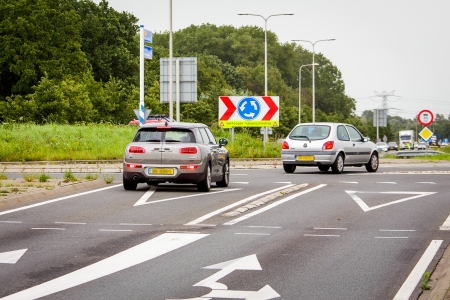In 2015-2019 an average 26% of fatal pedestrian crashes occurred at intersections. They can be subdivided into crash locations: 36% occurred in the urban area and 7% outside the urban area. The pedestrian share is almost half that of the average share of cyclists in fatal intersection crashes (54%) in that same period. This is also shown by Table 2 at the section How many casualties are due to crashes at intersections?
The degree of pedestrian safety at intersections depends on i.a. the intersection type, presence or absence of traffic lights and zebra crossings.
Intersection type
In general, roundabouts are safer for cyclists than conventional intersections and signalised intersections [37]. This is due to the speed reducing effect of a roundabout, simpler conflicts, and minimum conflict space [37]. As a rule, one-lane roundabouts are safer than multi-lane roundabouts [38]. Furthermore, several international studies show that pedestrians have a relatively higher crash rate, with a more severe outcome, at four-legged than at three-legged intersections [39]. Thus, the pedestrian risk of a fatal crash or serious injury crash is 10% higher at four-legged intersections than at three-legged intersections [40].
Signalised intersections
For pedestrians, signalised intersections are often safer than unsignalised intersections. At signalised intersections, there are fewer conflicts between pedestrians and motorised traffic due to time separation [41]. It should, however, be noted that at signalised intersections motor vehicles may be less inclined to reduce speed during the green phase, which may be more dangerous for pedestrians that start crossing at a later time during the green phase, which implies they partly cross during the red phase. Moreover, motor vehicles running red lights remains a major concern for pedestrians. Conversely, unsignalised intersections force motor vehicles to reduce their speed, since they need to be more careful.
Signalised intersection are, however, safer than intersections with only zebra crossings (see the next subheading) [41]. In addition, pedestrian green phases are sometimes (too) short or coincide with the green phase for turning motor vehicles. This leads to complex situations, particularly when a multi-carriageway road needs to be crossed [42]. In general, turning traffic at intersections (either signalised or unsignalised) is a concern for pedestrians, because they are often overlooked. At unsignalised intersections this is a greater concern, and more so in case of traffic turning left than in case of traffic turning right [42].
Zebra crossing
It is not unequivocal whether intersections with zebra crossings are safer than intersections without zebra crossings [41]. There are studies that claim that pedestrians are given priority by motor vehicles 30% to 40% more often than when zebra crossings are absent [43]. Other studies, on the other hand, do not find this effect [44]. A comparative study by Zegeer et al. [45] for example, found no decrease of pedestrian crashes for unsignalised intersections with zebra crossings. The studies even found an increase in pedestrian crashes when such intersections were passed by more than 12,000 vehicles a day. What needs to be noted is that these are American studies. Dutch zebra crossings may differ from American zebra crossings, e.g. because the latter often use continuous lines as a zebra crossing [42].
For more information about pedestrian safety, see SWOV fact sheet Pedestrians.
